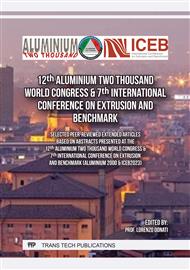[1]
P. Stratton, Raising productivity of aluminium extrusion with nitrogen, Int. Heat Treat. Surf. Eng. 2(3-4) (2008) 105-108.
Google Scholar
[2]
L. Donati, et al, Effect of liquid nitrogen die cooling on extrusion process conditions, Key Eng. Mater. 491 (2012) 215-222.
DOI: 10.4028/www.scientific.net/kem.491.215
Google Scholar
[3]
L. Donati, B. Reggiani, R. Pelaccia, M. Negozio, S. Di Donato, Advancements in extrusion and drawing: a review of the contributes by the ESAFORM community, Int. J. Mater. Form. 15 (2022) 41.
DOI: 10.1007/s12289-022-01664-w
Google Scholar
[4]
R. Pelaccia, M. Negozio, L. Donati, B. Reggiani, L. Tomesani, Extrusion of Light and Ultralight Alloys with Liquid Nitrogen Conformal Cooled Dies: Process Analysis and Simulation, J. Mater. Eng. Perform. 31 (2021) 1991-2001.
DOI: 10.1007/s11665-021-06320-z
Google Scholar
[5]
A.F. Ciuffini, et al., Surface Quality Improvement of AA6060 Aluminum Extruded Components through Liquid Nitrogen Mold Cooling, Metals 8(6) (2018) 409.
DOI: 10.3390/met8060409
Google Scholar
[6]
R. Pelaccia, B. Reggiani, et al., Liquid nitrogen in the industrial practice of hot aluminium extrusion: experimental and numerical investigation, Int J Adv Manuf Technol. 119 (2022) 3141–3155.
DOI: 10.1007/s00170-021-08422-3
Google Scholar
[7]
D. Pazeto, J.L.J Pereira, G.F Gomes, Numerical simulation and multiobjective optimization of fluid–structure interaction in aluminum extrusion, Int J Adv Manuf Technol 124 (2023) 545–566.
DOI: 10.1007/s00170-022-10543-2
Google Scholar
[8]
M.M. Marín, A.M. Camacho, J.A. Pérez, Influence of the temperature on AA6061 aluminum alloy in a hot extrusion process, Procedia Manuf. 13 (2017) 327-334.
DOI: 10.1016/j.promfg.2017.09.084
Google Scholar
[9]
I. Kniazkin, R. Pelaccia, et al., Investigation of the skin contamination predictability by means of QForm UK extrusion code, Mater. Res. Proc. 28 (2023) 543-552.
DOI: 10.21741/9781644902479-59
Google Scholar
[10]
J. Tang, L. Chen, Z. Li, et al., Evolution mechanisms of charge weld during porthole die extrusion of ZK60 Mg profile, J. Mater. Process. Technol. 300 (2022) 117401.
DOI: 10.1016/j.jmatprotec.2021.117401
Google Scholar
[11]
C. Zhang, Y. Dong, et al., Experimental and numerical investigations on transverse weld of hollow aluminum profile during porthole extrusion process, Procedia Eng. 207 (2017) 1653-1658.
DOI: 10.1016/j.proeng.2017.10.1095
Google Scholar
[12]
L. Donati, A. Segatori, M. El Mehtedi, L. Tomesani, Grain evolution analysis and experimental validation in the extrusion of 6XXX alloys by use of a lagrangian FE code, Int. J. Plast. 46 (2013) 70-81.
DOI: 10.1016/j.ijplas.2012.11.008
Google Scholar
[13]
M. Negozio, R. Pelaccia, L. Donati, B. Reggiani, Simulation of the microstructure evolution during the extrusion of two industrial-scale AA6063 profiles, J. Manuf. Process 99 (2023) 501-512.
DOI: 10.1016/j.jmapro.2023.05.075
Google Scholar
[14]
E. Giarmas, D. Tzetzis, Optimization of die design for extrusion of 6xxx series aluminum alloys through finite element analysis: a critical review. Int. J. Adv. Manuf. Technol. 119 (2022) 5529–5551.
DOI: 10.1007/s00170-022-08694-3
Google Scholar
[15]
R. Hölker, A.E. Tekkaya, Advancements in the manufacturing of dies for hot aluminum extrusion with conformal cooling channels, Int. J. Adv. Manuf. Technol. 83 (2016) 1209-1220.
DOI: 10.1007/s00170-015-7647-4
Google Scholar
[16]
M. Mazur, P. Brincat, et al., Numerical and experimental evaluation of a conformally cooled H13 steel injection mould manufactured with selective laser melting, Int. J Adv. Manuf. Technol. 93 (2017) 881-900.
DOI: 10.1007/s00170-017-0426-7
Google Scholar
[17]
A. Armillotta, R. Baraggi, S. Fasoli, SLM tooling for die casting with conformal cooling channels, Int. J Adv. Manuf. Technol. 71(2014) 573-583.
DOI: 10.1007/s00170-013-5523-7
Google Scholar
[18]
C. Tahri, P. Lequien, et al., CFD simulation and optimize of LN2 flow inside channels used for cryogenic machining: Application to milling of titanium alloy Ti-6Al-4, Procedia CIRP 58 (2017) 584-589.
DOI: 10.1016/j.procir.2017.03.230
Google Scholar
[19]
R. Pelaccia, P. E. Santangelo, A Homogeneous Flow Model for nitrogen cooling in the aluminum-alloy extrusion process, Int. J. Heat Mass Transf. 195 (2022) 123202.
DOI: 10.1016/j.ijheatmasstransfer.2022.123202
Google Scholar
[20]
R. Pelaccia, M. Negozio, et al., Assessment of the Optimization Strategy for Nitrogen Cooling Channel Design in Extrusion Dies, Key Eng Mater. 926 (2022) 460–470.
DOI: 10.4028/p-f7i0y2
Google Scholar
[21]
R. Pelaccia, B. Reggiani, M. Negozio, S. Di Donato, L. Donati, Investigation on the topological optimization of cooling channels for extrusion dies, Mater. Res. Proc. 28 (2023) 533-542.
DOI: 10.1016/j.promfg.2020.04.181
Google Scholar
[22]
M. Pizzarelli, Effectiveness of Spalart–Allmaras Turbulence Model in Analysis of Curved Cooling Channels, AIAA Journal 51(9) (2013) 2158-2167.
DOI: 10.2514/1.j052062
Google Scholar



